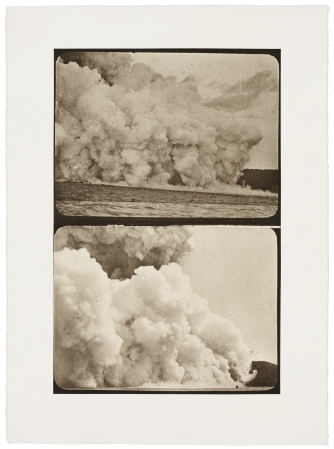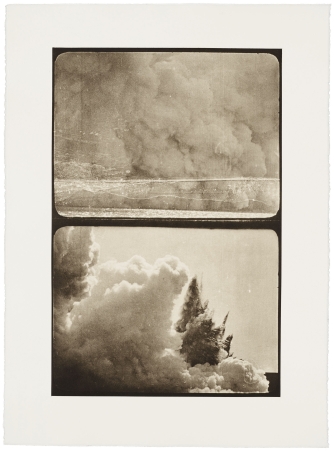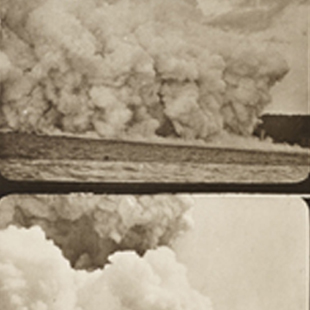Alexandra Navratil
*1978 Zürich, lebt und arbeitet in Amsterdam und Zürich
https://alexandranavratil.comSeptember 2021
-
 Krakatau 1930/1, 2021 Heliogravüre
Krakatau 1930/1, 2021 Heliogravüre
Auflage: 12
Bildgröße: 59,70 x 39,50 cm
Blattgröße: 76,00 x 55,50 cm
Produktion: Arno Hassler, Moutier
CHF 640.00 -
 Krakatau 1930/2, 2021 Heliogravüre
Krakatau 1930/2, 2021 Heliogravüre
Auflage: 12
Bildgröße: 59,70 x 39,50 cm
Blattgröße: 76,00 x 55,50 cm
Produktion: Arno Hassler, Moutier
CHF 640.00
Zwei übereinandergelegte Bilder formieren riesige Wolkengebilde, die sich bedrohlich auf dem Meer ausbreiten. Formelle Elemente wie die abgerundeten Ecken der Bildrahmen, die Flecken, Kratzer und andere Spuren lassen auf den ersten Blick erkennen, dass es hier einen Zusammenhang mit älteren fotografischen Aufnahmen gibt. In der Tat handelt es sich bei Krakatau 1930/1 und Krakatau 1930/2 um Ausschnitte einer Zelluloidfilmrolle, die im Archiv des EYE Filmmuseums in Amsterdam aufbewahrt wird. Die Rolle ist der physische Originalträger des holländischen Expeditionsfilms «Krakatau» aus dem Jahre 1930. Dieser gibt Einblick in das Leben von einheimischen wie auch europäischen Bewohnern von Niederländisch-Indien, der damaligen niederländischen Kolonie im indonesischen Archipel. Die abgebildeten Stills zeigen von einem Boot aus gefilmte vulkanische Eruptionen und die daraus folgenden Wolkengebilde. Bei genauerer Betrachtung wird ersichtlich, dass es sich bei den ausgewählten Filmstellen um Szenenwechsel handelt, wobei unterschiedliche Filmstreifen manuell zusammengeklebt wurden. Während die Klebestelle, ein sogenannter «Splice», auf der einen Druckgrafik als helle Linie klar erkennbar ist, zeichnet sie sich auf der anderen nur durch einen leichten Farbunterschied ab. In der Komposition kontrastiert die Formlosigkeit der Wolken mit dem klaren schwarzen Raster, der die einzelnen Stills umrahmt. Ebenso divergieren hier Inhalt und Form: Der Film, der damals unter anderem die imperialistische Macht der Niederlande spiegeln sollte, ist heute in seiner Materialität abgeschwächt und quasi dem langsamen Zerfall ausgesetzt.
Die Auseinandersetzung mit der Beziehung zwischen Bildträger und Bildmotiv zieht sich wie ein roter Faden durch Alexandra Navratils Werk. Der Frage, was zur abgebildeten Realität und was zum materiellen Bildträger gehört, geht die Künstlerin beispielsweise in der Arbeit Resurrections (2016) nach, in der sie mit Röntgenbildern arbeitete. Auf diesen lassen sich pathologische Erscheinungen nur schwer von sonstigen Spuren auf der Radiografie unterscheiden. Navratils Interesse für die materielle Zusammensetzung und eben auch Zersetzung des Bildträgers geht einher mit einem Interesse für die Geschichte des Films und der Fotografie in der frühen Moderne. Ihren Arbeiten liegen langwierige Recherchen zugrunde, die oft in Werkgruppen münden und ein Thema aus unterschiedlichen Perspektiven und in unterschiedlichen Medien beleuchten. Mit der hier beschriebenen Edition verwandt ist die Serie All That Slides, Strikes, Rises and Falls (2015), bei der Filmstills in Stoffstreifen gewoben wurden. Die Stills thematisieren ebenfalls Wolken, allerdings finden sich neben vulkanischen Wolken auch industrielle Dampfformationen und Rauchschwaden über Ölgruben. Während die textile Arbeit auf die Analogien im seriellen Herstellungsprozess der Textil- und Filmindustrie hinweist, schlägt das hier gewählte Medium der Heliogravüre sehr schön den Bogen zwischen einem der ältesten fotografischen Reproduktionsverfahren und der frühen Filmgeschichte. VH
